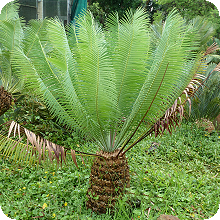|
| Division: Cycadophyta |
| Class: Cycadopsida |
| Order: Cycadales |
| Family: Zamiaceae |
| Genus: Encephalartos |
| Species: E. inopinus |
Conservation Status: |

E. inopinus
Lydenburg CycadEncephalartos inopinus (Latin: unexpected) or the Lydenburg cycad is an unusual, attractive African cycad (comparable to the Mexican companion Dioon or a Cuban Microcycas) that tolerates both sun and frost, making it a very desirable garden plant. It is threatened in the wild.
Plants are single or multistemmed (3-8 stems) and grow up to 2 m in height, sometimes up to 4 m in length for those with a procumbent (lying on the ground without rooting) growth habit. Plants have a distinctive bluish green foliage, covered with a silver powdery bloom. Male plants can produce up to five cones per crown, whereas the female plants produce between 1 and 3 cones per crown. Female cones are bluish green when young, becoming greenish yellow when mature; male cones remain a bluish colour, similar to the leaves, even at maturity. Plants sucker freely.
Cultivation:
E. inopinus is well suited to temperate and subtropical climates. It makes a good garden subject on its own or can be mixed with aloes, euphorbias and any other succulent plants to create a water-wise garden in full sun. Furthermore, it is fascinating if grown together with palms and herbaceous perennials where a tropical effect is desired. It is ideal as a pot plant, and remain admirable for its entire growing period.
Propagation of E. inopinus is easy from seeds or suckers. It requires a minimal amount of water and unfortunately is more vulnerable to rot infection than most other cycad species. The rainfall in its natural environment is about 375 mm per year, mainly in summer. Improve soil drainage or grow these cycads on a slope, as they are often found in nature, to prevent rot.
| semi-shade | blue-green | very low watering | fast growth | frost-resistant | rare |
E. inopinus is well suited to temperate and subtropical climates. It makes a good garden subject on its own or can be mixed with aloes, euphorbias and any other succulent plants to create a water-wise garden in full sun. Furthermore, it is fascinating if grown together with palms and herbaceous perennials where a tropical effect is desired. It is ideal as a pot plant, and remain admirable for its entire growing period.
Propagation of E. inopinus is easy from seeds or suckers. It requires a minimal amount of water and unfortunately is more vulnerable to rot infection than most other cycad species. The rainfall in its natural environment is about 375 mm per year, mainly in summer. Improve soil drainage or grow these cycads on a slope, as they are often found in nature, to prevent rot.
E. inopinus for sale at AfricaCycads.com:
